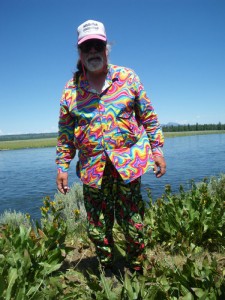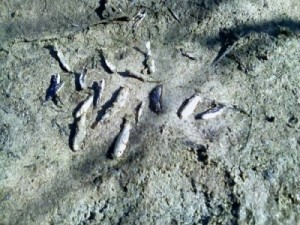If you are interested in helping study the effects of the South Fork Boise River flow changes on the wild trout fishery in September, read more below and contact us with your availability.
For several years the South Fork Boise River wild trout fishery has been getting significant attention from a number of sportsmen, state and Federal resource agencies. You reading this website story is just one example. River flow changes and effects on the aquatic system has gained attention with angler concerns about potential adverse effects on juvenile rainbow trout and macroinvertebrates (aquatic insects that provide a food base for trout), when Anderson Ranch Dam flows are routinely ramped down to 600 cfs and 300 cfs as irrigation storage releases are ended in September.

Whitefish Ed in his formal fishing dress on the banks of the Henry's Fork (photo from westfly message board)
Back in November 2009 interested anglers and agency staff met at the Boise Public Library to hear about a genetic study of the South Fork Boise River fishery. During a panel discussion several topics came up, including flow management.
Could the Bureau of Reclamation do something to change their flow management? There was no answer to that question, but the topic did stick with one local angler who goes by the handle “Whitefish Ed” on the westfly.com message board.
Ed initiated his own study and looked at the SFB on September 15, 2011, a few hours after the flow dropped from 600 to 300 cfs, and observed many stranded wild juvenile trout along the river’s shoreline in three locations. You can find Ed’s story at this westfly.com message thread which is worth the read. Ed’s writing style is as colorful as that shirt he is wearing in the photo
After some meeting this spring with state and Federal agency biologists a plan has been hatched to look at juvenile trout stranding along the South Fork. IF we are ever going to see changes in flow releases we need the information to support the change. The data collected last year by Whitefish Ed is a great start and it has focused the attention of the angler groups and agencies. A logical next step is to get a handle on how widespread the problem may be. Is it limited to “hot spots” along the river or will we find stranded fish in a uniform pattern? And, it’s fair to ask how much does this matter to the fishery?
The long-time conventional wisdom has been when the flows drop on the South Fork Boise River anglers should give it a few days for the fish to readjust. Perhaps we have all been turning our back on the fishery and not been there to observe stranding. This year we are going to start to get a handle on it.
Anglers and agency staff from Idaho Fish and Game and the Bureau of Reclamation are going to cooperate in a study to get a better understanding of the extent of stranding, and the degree that it may be a problem for the wild trout fishery. Volunteers are needed!
We expect the river to drop from 600 cfs to 300 cfs over the span of a few hours in mid September. At this point we believe the date of the flow decrease will be Monday September 17th.
Here’s the catch: we don’t know yet the exact date when the river flows will decrease. We hope to have a two-week notice from the agencies. But we need to plan for the work and we need to hear from people who might be interested in volunteering.
If you can help on the day in September please contact us at tutedtrue@aol.com or call Andy Brunelle 343-1510.

A September 17, 2007 photo of some stranded juvenile fish on the shores of the South Fork Boise River just upstream of Rough Creek. (photo courtesy of Andy Brunelle)
When we learn of the date the river flows will be decreased in mid September we will follow up with another general announcement, and we will also send out and email specifically to those who have indicated they want to help.
As part of the work we will be providing dinner at a camping area the night prior to the flows being decreased. We will provide some training at the camp site. We expect flows will be dropped in the night so we want to dispatch to the river banks at early light to look for stranded fish before the fish are eaten by predators.
Please let us know of your interest and pass the word on to other anglers and those interested in the South Fork Boise fishery.







Pingback: Salute to Whitefish Ed – 2012 Man o’ the Year for 2012 |